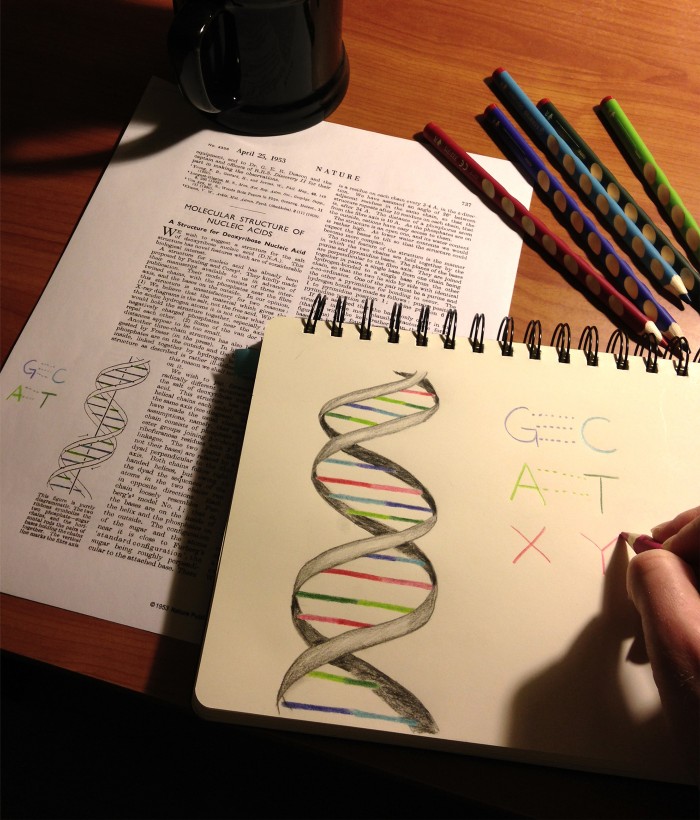Startup’s Artificial DNA Could Revolutionize Drug Design
Four letters of DNA write the universal code shared by all of life. Or at least they used to. Synthorx, a biotech startup in La Jolla, California, is designing microbes with an expanded genetic alphabet containing six letters, adding the synthetic X and Y to the natural A, T, G, and C. These bacteria have no counterparts in nature, and Synthorx is using them to design novel proteins that hold promise as the basis for future painkillers, antibiotics, and cancer-targeting compounds.
The company is based on the work of one of its founders, chemist Floyd Romesberg at the Scripps Research Institute in San Diego. For over 15 years, Romesberg tinkered away perfecting a pair of artificial DNA letters that would work congruently with the genetic machinery of life, but not be so similar as to get mixed up with existing letters. In 2012, Romesberg’s lab published the creation of X and Y, and in 2014, he showed that bacterial cells could replicate and propagate genes containing X and Y into future generations.

“People always thought there was some complexity, or that it would be very difficult to imitate life,” Romesberg says. “It really suggests that the molecules of life are not privileged in any sort of special way.”
Two years ago, no one had used X and Y to do anything useful. But Romesberg’s goal was to create drugs too complex to make using conventional chemistry. “I can’t do that in my lab,” Romesberg said. “So starting a company solely focused on that is a way to get that done.” Along came Synthorx.
The creation of X and Y is a scientific landmark itself, yet Synthorx’s true advance lies in the utilization of these letters to make new proteins. Simply adding the DNA letters X and Y hypothetically allows cells to make proteins with up to 172 different amino acids, compared to nature’s set of 20.
“A lot of those amino acids are pretty redundant,” Romesberg says. “And to a medicinal chemist who spends their career making drugs, that must look extremely limiting.” Using synthetic amino acids, scientists could make an existing protein bind to its target more strongly, resulting in a more effective drug. Another idea is to engineer a protein to bind to one specific target while avoiding very similar targets in the hopes of eliminating dangerous side effects. One such project at Synthorx aims to turn a spider venom into a non-opioid, non-addictive painkiller.
Novel antibiotics and drugs for metabolic disorders are also on the agenda. “Insulin would be a great target,” Synthorx CEO Court Turner says. “It is already produced in E. coli, but it has to be injected on a daily basis.” Incorporating the right synthetic amino acids into insulin molecules could make a long-lasting version so that diabetics only need to inject it every few days or once a week.
There seems to be no doubt among scientists that if this technology works, it will be revolutionary. But until now, there has been no impetus to dream wildly about the applications of an expanded genetic alphabet and the ability to make proteins with a breadth of unnatural amino acids. Marc Lajoie, a synthetic biologist at the University of Washington, says, “It is really just an imagination problem, and to be honest, even thinking about using one unnatural amino acid is a bit crazy for some people.”
Keep Reading
Most Popular
Large language models can do jaw-dropping things. But nobody knows exactly why.
And that's a problem. Figuring it out is one of the biggest scientific puzzles of our time and a crucial step towards controlling more powerful future models.
How scientists traced a mysterious covid case back to six toilets
When wastewater surveillance turns into a hunt for a single infected individual, the ethics get tricky.
The problem with plug-in hybrids? Their drivers.
Plug-in hybrids are often sold as a transition to EVs, but new data from Europe shows we’re still underestimating the emissions they produce.
Stay connected
Get the latest updates from
MIT Technology Review
Discover special offers, top stories, upcoming events, and more.